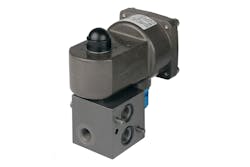4 potential solenoid valve failure modes and how to avoid them
Solenoid valves control critical systems like hydraulic or pneumatic actuators, emergency shutdown valves and high-integrity protection systems (HIPPS), but there is one thing they can’t control — the weather. While heat and humidity only make people feel sticky, they can make solenoid valves actually be sticky. When valves stick, failing to open or close as required, they risk shutting down processes and incapacitating safety systems. And extreme weather events, including flooding, only make a sticky situation worse. A sticky valve can cause a safe failure (e.g., process is shut down unnecessarily) or a dangerous failure (e.g., risk of explosion). Failure can decrease plant safety, cause lost production and even cause damage to downstream equipment.
It is important to identify whether the valve is stuck in the open or closed position in order to diagnose and solve the problem. Here are four potential solenoid valve failure modes and how to avoid them:
1. Typical spool-style valves have large dynamic seals that dry out if not properly lubricated and maintained. The problem is, changing operating conditions (temperature, humidity, cycle rate) make it hard to predict when that maintenance will be required. Fluid contaminants can increase under extreme conditions, making the problem even worse. Direct-acting poppet valves are inherently less vulnerable to fluid contamination. In addition, a poppet valve with a high force/friction ratio (FFR) can increase a safety factor tenfold.
2. Valves with a wet armature design can allow moisture and other impurities to enter the core tube area, causing the valves to stick.
Selecting valves with a dry armature and a diaphragm that isolates the media (air or gas) from the armature keeps moisture and contaminants out.
3. Sometimes residual magnetic force will cause valves with wet armature to stick open when the coil is de-energized because there is insufficient internal power to move the coil.
Valves with robust spring force address this problem. A leading solenoid valve on the market has a 4.7kg spring, two to five times the next closest valve.
Selecting a valve with a more efficient magnetic path overcomes this problem as well. This includes both the design and materials. A smaller gap between the armature and core reduces the current needed to maintain the magnetic flux against the spring. And soft magnetic materials mean the drop out is very reliable. This combination makes the valve very snappy on changeover, both opening and closing.
4. Pilot-operated valves often have a pilot mechanism with small vent ports that can allow internal moisture to infiltrate, causing contamination and internal corrosion. Again, when the valve is de-energized, there is not enough internal power to move the coil, leaving it stuck open.
This is another sticky situation where selecting direct-acting poppet valves with high FFR is the solution. These valves require no minimum supply pressure, so they will reliably close when de-energized.
Selecting a solenoid with the right design and construction allows operators to protect processes and systems from failure caused by sticky solenoids.
Andrew Barko is Application Engineer – Energy at IMI Precision Engineering. He may be reached at [email protected]or at 720-651-1665. For more information, visit www.imi-precision.com.
* "Herion" is a registered trademark of Norgren GmbH, an IMI Precision Engineering branded company.


